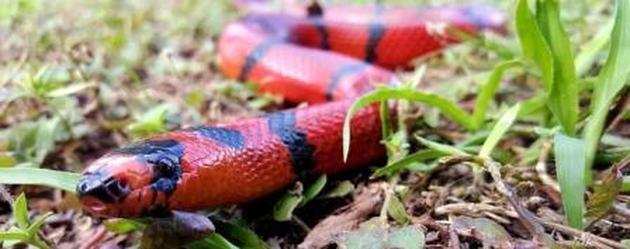Honduran Milk SnakeLampropeltis triangulum hondurensis |

Custom Search
|
|
The Honduran milk snake or Honduran milksnake (Lampropeltis triangulum hondurensis) is a non-venomous colubrid snake found in Nicaragua, and Northeastern Costa Rica and as its common name indicates Honduras.
They are considered a subspecies of milk snake. One of several quite similar milk snake subspecies found from southeastern Canada through most of the continental United States to Central America and northern South America. They inhabit low to medium elevations of the sub-tropical rainforest and grassland, usually among the leaf litter present on the ground. Being so close to the equator, the climate in their habitat sustains less seasonal variation. These snakes are found from sea level up to 5,000 feet in higher mountainous terrain. In the wild, the Honduran milk snake occurs in 2 different coloration varieties, known as the tricolored and the tangerine phase. Usually, their base color is red with very distinct rings or bands of black and yellow, the tricolored. However if instead of yellow rings, there are deep orange ones the specimen is referred to as a tangerine phase. These rings may or may not extend onto the belly and completely encircle the snake. The Honduran milk snake is considered one of the largest milk snake sub-species larger than the Eastern milk snake found in the USA. Adult snakes average 4 to 5 feet in length, but very large captive specimens measuring up to 6 or 7 feet in length are known. On average they weigh about 2.8 pounds (1.27 kg). They are among the most common milk snakes bred in captivity, with several morphs being "created" by breeders, such as Anerythristic, Snow, Hypo, Ghost to mention a few.
These are solitary animals and are rarely seen basking in the sun during the daytime, they prefer to stay under an object or rock in direct sunlight, absorbing heat indirectly from the underside. It's probably much easier to spot them crossing roads at night.
The hibernation or more accurately brumation period lasts from late October or early November until April or May. When active these snakes are diurnal in the spring and fall and become nocturnal during the hot summer days. Like most snake species when threatened, the Honduran milk snake will try to flee, but if cornered, they will stand their ground, raising the head ready to strike. Sometimes they shake the thin tail quickly in leaf litter which makes them sound like a rattlesnake. Using quick, jerky movements they also try to startle potential predators by flashing their bright colored bands as a danger signal. Their pattern resembles that of venomous coral snakes in an attempt to protect them from predators. Their lifespan in the Wild is about 15 years while in captivity they reach 20 or more years. Their predators include birds of prey, wild felids, and of course humans which often kill them out of fear and confusion with dangerous snakes. Taxonomy / Etymology
The Genus name Lampropeltis is derived from 2 Greek words lampros meaning "bright" and pelta which means "shield". While the species-specific name triangulum is derived from the Latin word triangulus meaning "having three angles". The subspecific scientific name hondurensis is a Latinization Honduras, which is their primary country of origin even though they are also found in other countries. Diet / Feeding Their diet in the wild includes small mammals like voles or rodents such as mice and rats, birds and eggs. They also eat other reptiles like lizards and other snakes including their own species and even venomous snakes (ophiophagy). Honduran milk snakes are opportunistic feeders, and use constriction to kill their prey, by wrapping their body tightly around the animal until the blood flow stops. Milk snakes are very beneficial, particularly for farmers, since they hunt down small rodents considered pest often found on farm buildings and barns. Reproduction The mating season occurs in May just after they emerge from brumation. This is an oviparous species, meaning that they lay eggs, usually, females lay 3 to 24 leathery-shelled eggs per clutch normally in early June. The eggs are laid decaying plants, beneath rocks, rotting logs, compost or manure piles, under boards, and in loose soil. Sometimes females come together at communal egg-laying sites, most likely because of the lack of suitable nesting sites, and not for socialization reasons. After an incubation period of about 10 weeks, the eggs hatch in August or September. The hatchlings are quite large and robust around 8 inches long, and also have a darker coloration than their parents. The little snakes will start feeding after their first skin shed, which may occur anywhere from 5 to 10 after birth. Just as many other reptile species, the egg's incubation temperature determines the sex of the young warmer temperatures equals more males while cooler more females.These snakes become sexually mature at around 18 months of age. Conservation / Threats The Honduran milk snake is not listed in the IUCN and CITES Appendix II. Although still common in their native habitat, their number in the wild are affected by habitat loss, road mortality, and human persecution who kill them believing they are venomous or dangerous.
|
Did You Know?
The Australian inland taipan bite contains enough venom to kill up to 100 full grown men. Scientific classification |
© 2014 Snake Facts About Us | Privacy Policy | Contact





